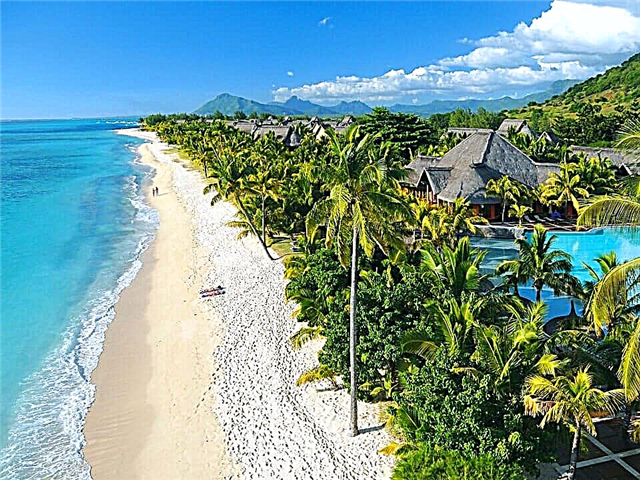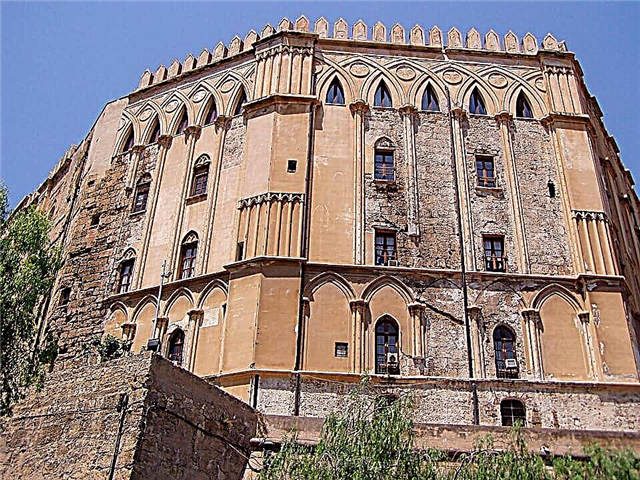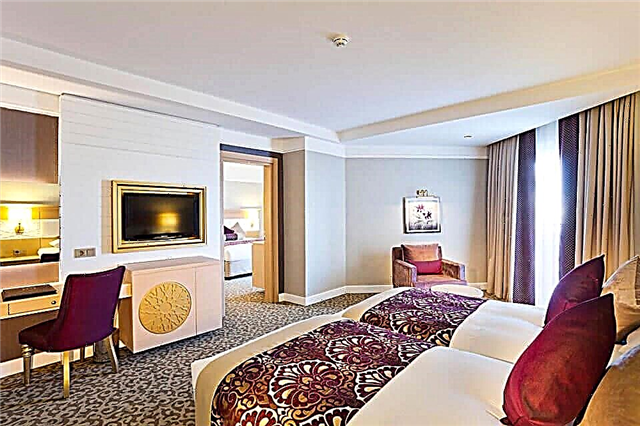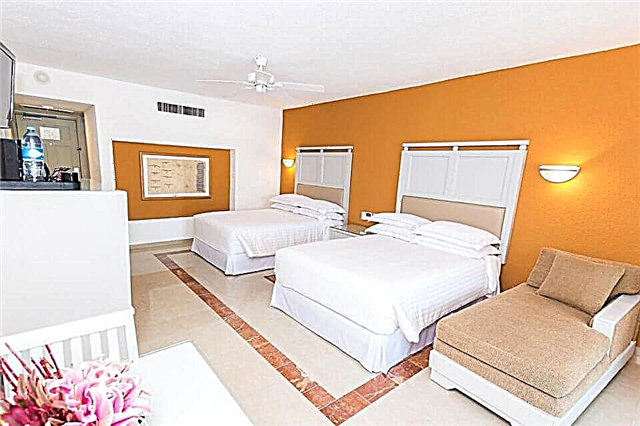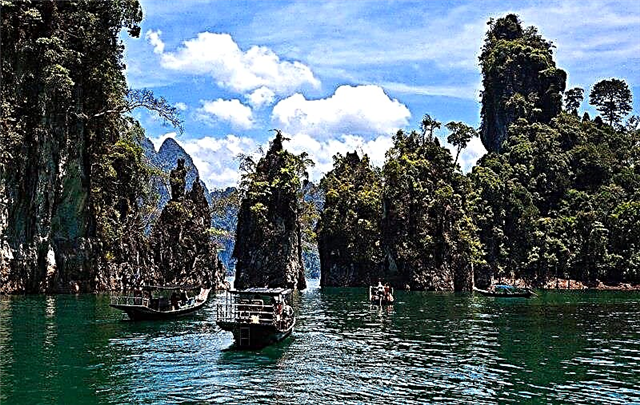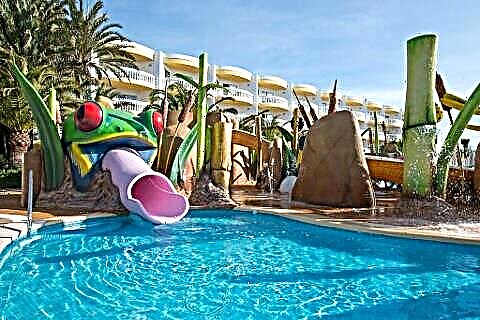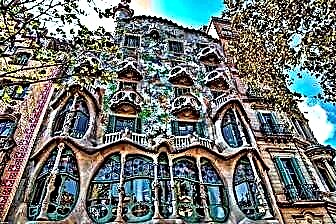Barcelona is a true European “pearl” with a rich historical heritage and excellent prospects. The capital of Catalonia was founded in the 3rd century BC. Carthaginian commander - the father of the famous Hannibal. Since then, the city passed from the Romans to the Visigoths and Moors, and then to the descendants of the Frankish kings. At the same time, it constantly developed and subsequently became the capital of the powerful Catalan-Aragonese kingdom.
Barcelona attracts millions of tourists every year. It is a city with magnificent Gothic quarters, beautiful Catholic churches, Gaudí's immortal creations and the unique atmosphere of the Mediterranean embankments. Vivid national festivals “La Merce”, “Parade of Magic Kings”, “Gracia” reveal the local culture in all its glory and allow one to plunge deeper into traditions.

The best hotels and hotels at affordable prices.
from 500 rubles / day
What to see and where to go in Barcelona?
The most interesting and beautiful places for walking. Photos and a short description.
Sagrada Familia
An unusual Catholic church in the Art Nouveau style, which is being erected according to the unique project of the famous Antoni Gaudi. The building is still being built exclusively with donations from everyone. La Sagrada Falimia is considered one of the world's most visited attractions, with visitors to Barcelona queuing up for hours to climb the bell tower or explore the quaint interiors.

Rambla street
The most famous promenade in Barcelona, the symbol of the city. Separates the old Gothic Quarter from the Raval district. The Rambla is an iconic place for tourists. Here they relax in street cafes, watch improvised performances of street artists, buy souvenirs. Even before the beginning of the large tourist influx, the boulevard was loved by the locals, but now they are very rarely found in the many-sided mass of walking guests of the city.

Gothic Quarter
The medieval quarter, the very heart of the city, is home to many interesting sights. Ancient stone houses of the XIV-XV centuries. separated by narrow streets, traditional tapas bars are located on the ground floors of the buildings. There are also modern shops, trendy restaurants and clubs. Stormy life is in full swing until dawn, preventing the locals from sleeping. Only in the morning hours does the Gothic Quarter quiet down.

Park Guell
The city park designed by Antoni Gaudi. Initially, it was conceived as a place for the construction of mansions of wealthy citizens, but the project failed and the owner of the land - industrialist E. Guell sold the park to the authorities. The area is decorated with figures and sculptural groups created by the famous architect, as well as several houses of his work. The park houses a public school and several administrative buildings.

Ciutadella Park
Also called the Citadel Park. Before the destruction, this Citadel was one of the largest fortresses in Europe. Museums, a zoo, an artificial lake, the Parliament of Catalonia - it will take a whole day to explore the park. One of the sculptures that adorns the park's fountain was created by Antoni Gaudi himself. The buildings specially built for the World Exhibition of Buildings are noteworthy - the Winter Garden, the Palm Conservatory and the Castle of the Three Dragons.

Orth's Labyrinth
Historical park on the side of the mountain. The landscape is represented by neoclassical and romantic gardens. To preserve the park, there is a restriction on visiting it - no more than 750 people can be in it. The park contains the former palace of the Desvalls family with a medieval tower. The labyrinth that gave its name to the park consists of cypress trees. The hedge is 750 meters long and 2.5 meters high.

Mila's house
One of the most interesting sights of Barcelona, created by Antoni Gaudi. The house was built by order of the Mila spouses, who planned to rent out some of the rooms. Gaudí used the concept of a "moving mountain" during the construction, so the lines of the building seem to be alive and "fluid". The house is considered one of the spiritual symbols of the city. Nowadays, people live in one part of it, and the upper floors are given over to a museum.

Casa Batlló
Rebuilt in the 1900s. A. Gaudí's apartment building of Josep Batlló y Casanovas, which after reconstruction became an architectural masterpiece, an ideal example of the thought of a brilliant architect. Researchers of Gaudí's work believe that the work on the building marked the beginning of a new independent stage in the architect's work. Ideas tested at Casa Batlló, he used for his further creations.

House Vicens
One of the first major works by Antoni Gaudi. Residential building, protected as one of the UNESCO heritage sites. Constructed from raw stone. Decorated with colored ceramic tiles with floral designs. An interesting fact is that the manufacturer of the tiles was the customer himself - the manufacturer Manuel Vicens. Turrets, balconies, facades were used as decorative elements. This gives the house a dimension.

Agbar Tower
Modern building of 34 floors, erected using advanced engineering technologies. Outside, the tower shimmers in different colors, inside the structure independently opens and closes the blinds and regulates the power consumption. The optimum temperature is also independently maintained. The name "Cucumber" was stuck behind the tower because of the rounded conical shape of the roof.

Palace Guell
Residential building in Venetian style. One of the earliest works of Antoni Gaudí, the famous architect. The complex design of this structure is located between two other houses on a small area measuring 18 by 22 meters. The palace is crowned with a dome of an unusual shape. The interior decoration contains many elements of different architectural styles. And Gaudi himself was the designer of all the furniture in the palace. The palace is open to visitors every day.

Spain square
One of the central city squares, located at the foot of Montjuïc Mountain. It appeared thanks to the 1929 World's Fair. In the center of the square stands a huge musical fountain by the Catalan sculptor M. Bligh. From time to time, bright light and music performances are held here. The architectural ensemble of the square is intended to symbolize the unity, greatness and power of the entire Spanish nation.

Plaza Catalunya
Beloved by both Barcelona residents and guests of the city, the square, from where the main city routes start. Here begins the Rambla, the street "Paseo de Gracia", here the borders of the old and new districts of Barcelona converge. Tourist buses and transport to the airport and suburbs stop at Plaza Catalunya. The place is popular and always full of people, even at night.

Royal square
Located in the Gothic Quarter. It is often confused with King's Square in the same quarter. Royal Square is often a gathering place for people. Celebrations, festivals and entertainment events are held there. The square was built in a romantic style in the 19th century on the site of the burnt down Capuchin monastery. She conquers travelers with beauty and grace. The special decoration of the square is the Three Graces fountain.

Spanish village
An open-air exposition consisting of more than 100 structures. The museum presents different parts of Spain: copies of traditional residential buildings from Andalusia, Galicia, La Mancha, Aragon, Asturias and other regions of the country. In the village you can walk along the streets, eat in a traditional restaurant and buy souvenirs. The complex was created for the 1929 World's Fair, and then preserved as a museum at the request of the townspeople.

Palace of Catalan Music
Concert hall in the Art Nouveau style, located in the center of Barcelona near the Gothic Quarter. The building is richly decorated with mosaics and figured frescoes, the auditorium is crowned with a roof with colored stained-glass windows, wide windows are also made of colored glass. Famous folklore performers, classical orchestras and contemporary musicians with original programs perform at the Palace of Music.

Hospital Sant Pau
The hospital complex of 27 buildings is a UNESCO World Heritage Site. The hospital was founded in 1401. It was only in 1901 that the construction of a modern building began, which lasted 29 years. The architect Lewis Domenech y Montaner built the Art Nouveau departments of the hospital and connected them with underground passages. The building looks more like a palace than a hospital. Its walls are decorated with intricate decorations.

Picasso Museum
Collection of paintings by the famous artist, is located in the palace "Berenguera d'Aguilar" in the quarter "La Ribera". The museum mainly displays works from the early period of Picasso's work, there are several later works. In addition to the paintings themselves, there are exhibitions of ceramics, engravings, photographs. On the territory of the museum, lectures are periodically held, which tell about the life and work of Picasso.

National Art Museum of Catalonia
The building of the gallery is located on Montjuïc mountain and is part of the National Palace complex. The museum has been operating since the 90s. XX century, the exposition is collected from two funds - the Museum of Art of Catalonia and the Museum of Modern Art. It contains several paintings by El Greco and Velazquez, as well as engravings, photographs, woodwork, coin collections, old banknotes, medals. There are picturesque fountains at the entrance to the National Palace.

Barcelona History Museum
Located on the Place Royale in the Gothic Quarter. Combines several historical sites. The most interesting is the underground complex of ancient structures. You need to go down to it by elevator 12 meters underground. The museum complex also includes the Pedralbes Monastery, the Park Guell Entertainment Center, Park Guell, the Verdaguet House Museum, the Temple of Augustus and the Plaza del Rey Ensemble.

Joan Miró Foundation
Modern Art Museum. The founder is Joan Miró, an avant-garde and surrealist of the 20th century. The museum is a platform for exhibitions of young contemporary avant-garde artists. For the construction of the building, the architect chose a site in a park on the mountain. He created a unique Mediterranean-style building with arches between exhibition halls and glass roofs. An excellent and picturesque view opens up from the roof of the museum.

CosmoCaixa Museum
Science Museum, one of the most famous in Europe. The construction costs of the Art Nouveau museum building at the beginning of the 20th century amounted to about 100 million euros. Its area is over 40,000 m². The museum is interactive, not only scientific, but also educational. Expositions of different scientific categories are presented in an entertaining way, which is interesting for both children and adults. Visitors can experiment - trigger a tornado or create a sandstorm.

Barcelona Erotic Museum
Despite its unusual theme, it is one of the most visited in Barcelona. The fund of the museum contains more than 800 exhibits, some of them are of considerable archaeological value. Historical exhibits allow us to trace how erotic motives have changed in the cultures of different peoples. Among them there are both explicit sculptural compositions and erotic works by Picasso. And at the entrance to the museum you can take a glass of champagne.

Triumphal Arch
The symbolic entrance to the Ciutadella Park, 30 meters high. It was built of red brick with stone and ceramic tile decorations. The architect was Josep Vilaseca. The arch was created by sculptors - Josep Reines, Josep Limona and Antoni Vilanova. The style of the composition is neo-Moorish. The arch is decorated with 50 coats of arms - of Barcelona itself and other Spanish provinces. Bats are carved from stone on the columns.

Barcelona Cathedral
The main Catholic church in the city is located in the Gothic Quarter. The cathedral was erected on the site of a Roman basilica of the 6th century, where the relics of the holy martyr Eulalia, the patroness of Barcelona, were kept. After the Moors destroyed the basilica, the early Romanesque cathedral was rebuilt in the 11th century, and the Gothic building appeared in the 13th century. In subsequent centuries, the temple was completed, the main facade appeared already in the 19th century.

Monastery of Pedralbes
Located in a wealthy and prestigious area of Barcelona. The monastery itself is distinguished by its luxurious interior decoration and splendor of interiors. It was erected at the behest of Queen Elisenda de Moncada during the heyday of the Catalan Gothic architectural style and became an excellent example of this school. Some cells do not look like monastic ones at all - they are decorated with magnificent frescoes and ornaments.

Monastery of Montserrat
Millennial Benedictine monastery dedicated to the Catalan Mother of God. It is located in a picturesque place among the rocks, the walls of the buildings seem to be "glued" to the rock. On the territory of the monastery there is a museum where you can admire the creations of Caravaggio, Picasso, El Greco, Dali. Montserrat appeared in the 11th century thanks to the efforts of the Rev. Abbot-Architect Olibe Ripolsky.

Church of Santa Maria del Mar
An ancient temple in the La Ribera quarter, a classic example of the Catalan Gothic style. The church was built in the XIV century with donations from seafarers and merchants who needed their patron. At this time, in Barcelona, there was just a flourishing of navigation, sea trade and discoveries. The outer doors are decorated with reliefs depicting scenes of ship life. The church often hosts classical music concerts.

Mount Tibidabo and the Temple of the Sacred Heart
Tibidabo rises 500 meters above Barcelona. A legend from the Gospel is associated with the name of this mountain, according to which Satan in this place tempted Jesus with unearthly beauty and power. On the mountain there is an unusual temple of the "airy Gothic" style with a statue of Christ at the very top. This is the Cathedral of the Sacred Heart, it has a magnificent interior and graceful architecture. The mountain can be reached by funicular, bus or tram.

Monument to Christopher Columbus
Monument to the Discoverer of America, erected at the end of the Rambla. The structure rises 60 meters above the historic port, where Columbus arrived at the end of his landmark voyage. The monument was erected in 1888. The base of the column is decorated with bas-reliefs telling about the voyage of the pioneer; at the top there is a small observation deck from where you can admire the sea and city quarters.
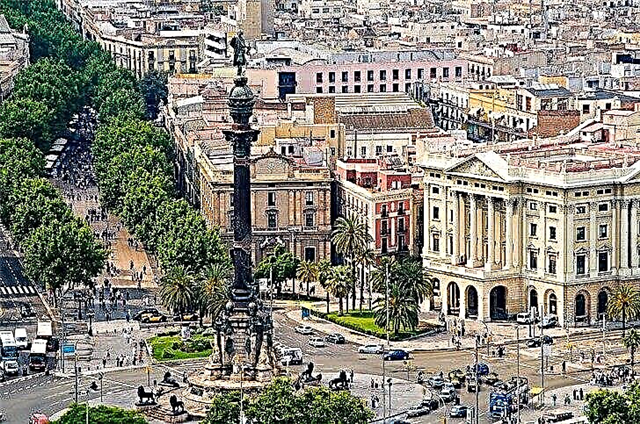
Montjuïc fortress
The building is crowned by the mountain of the same name within the boundaries of Barcelona. Until the 16th century, there was a watchtower, in the middle of the century (during the period of the Catalan uprising against the Habsburg rule) a fortress wall and defensive structures appeared. In the 18th century, the British took the fort, but very soon the Spaniards recaptured Montjuïc. Today, a military museum is located on the territory of the fortress.

Magic Fountain of Montjuic
Color and music fountain in the square in front of the National Palace, which is located on the Montjuïc mountain. The fountain was built in 1929 for the World's Fair, renovated and renovated in 1992 in preparation for the Olympics. The lighting system of the structure (about 5000 light sources in 3600 streams of water) creates interesting visual illusions during operation, which is why the fountain was called "magic".

Barcelona Aquarium
One of the largest European oceanariums, which contains 11 thousand representatives of the aquatic world. It is an important center for the study and conservation of the natural diversity of the Mediterranean. The aquarium features 14 ecosystems: caves, grottoes, coral reefs, rocky coastline, sandy coastline, algae colonies. Several ecosystems represent the tropical natural belt.

Camp Nou Stadium
The stadium where the famous, revered and almost cult football club Barcelona is training. Football fans and supporters consider this place a real symbol of the city and, first of all, strive to get here. The stadium seats almost 100,000 spectators and is the largest in Europe. Barcelona has been awarded 5 stars by FIFA for functionality, convenience and capacity.

Boqueria market
Shopping arcade dating back to the 13th century. The colorful Boqueria is a great place to eat and shop for Catalan delicacies. There is everything here: fresh seafood, excellent seasoned ham, a wide variety of fruits and vegetables, wines, Catalan sweets, the best cheeses. On Boqueria, tourists will be able to fully appreciate the generosity of the fertile lands of the Mediterranean and its underwater depths.

3 best beaches in Barcelona
Popular beaches rating, photos and a short description.
Nova Mar Bella beach
Municipal beach. Reconstructed and refined in the process of preparing the city for the Summer Olympic Games. The clean and beautiful sea, fine sand attract tourists, but the view is somewhat spoiled by new buildings on the shore. The beach is just over 400 meters long and about 40 meters wide. A feature of the beach is its section, which was chosen by nudists. There is a medical aid station on the beach, lifeguards are on duty.

Bogatel beach
For improvement and cleanliness, he was awarded the Blue Flag. The beach is 640 meters long and 39 meters wide. This is a municipal beach, admission is free. The beach is not touristy, there are few people on it. For outdoor enthusiasts, there is a beach soccer field, a ping-pong table, and a volleyball net. You can rent a surfboard and kayak, sun loungers and beach umbrellas.

Barcelonetta beach
The oldest and most famous city beach, located on a wide sandy spit. The territory of Barcelonetta stretches to the Olympic Port. There are many clubs, restaurants, bars, volleyball courts and other active activities on the beach. The place is popular with young people, because during the high season the vigorous activity does not stop here for an hour, discos and dances are held even during the day.


